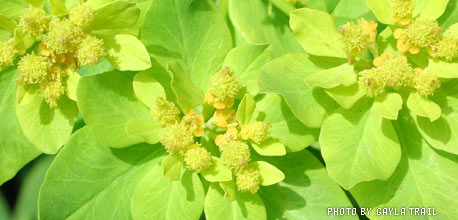 Guest post by Teresa Youngblood
Guest post by Teresa Youngblood
Gardening was making me a little crazy, and this before I had planted a single seed.
I always wanted to grow up to be one of those peaceful, well-adjusted, earthy women who live with gusto and who tend wild, luscious gardens. I think this was because, as a child, I was bookish, possessed of few friends, and likely to blurt out odd things in the middle of other people’s conversations. The skillful, nurturing, and wise gardener was the antithesis of my extended geeky phase. It was more of a mental picture than a plan, though, and I clipped through college and then graduate school with nary a spider plant to call my own, much less a laid-back, carefree approach to living.
But one day, a few years ago, I found myself graduated, in a new city, and living on a second-floor apartment. I had no clear goals for my future, but I did have a balcony. So in lieu of taking up panic attacks, I decided to start a garden.
I immediately began planning a brave and inspiring balcony garden. Never mind that I didn’t know a thing about gardening. I wanted the kind that wantonly spilled vivacity and cheer over the side of an otherwise sterile building. And since I knew not a soul who had a knack with plants, I set off for the city library.
It was September, and because I did not know yet that winter gardening existed, I made a plan to research gardening until the spring. The first two books I checked out were Rodale’s All-New Encyclopedia of Organic Gardening and John Jeavons’s How to Grow More Vegetables Than You Ever Thought Possible on Less Land Than You Can Imagine. They were just what I needed—pages and pages of facts, how-tos, tricks of the trade, and important ecological philosophy.
I found plenty more information to keep me busy until March. I made charts and copied graphs. I spent hours surfing gardening websites and creating a list of my favorites. I perused back issues of the Organic Gardener and Mother Earth News. By January I had moved on from reading about gardening and was reading about heirloom varieties and seed saving, the World Bank and global food issues, the waning of the back-to-the-land movement of the ’70s, and the history of the Dole family and the hijacking of Hawaii.
And so, by February I was convinced that the only way I could call myself a real gardener was if I moved out to the Canadian countryside, grew all my own organic food, and checked out of the cash economy.
This was not turning out to be the harmonious hobby I thought it was. I needed space. Gardening was making me a little crazy, and this before I had planted a single seed.
So on my next trip to the library I picked up Michael Pollan’s Second Nature and Jamaica Kincaid’s My Garden (Book). I thought perhaps that other bibliophiles would have advice on what to do after the crash.
And I was right. Aside from incredible writing, I found in these two books some perspective. As the authors told the stories of their first gardens, I recognized the impulsiveness, the eagerness to always know more, and the difficulty in finding a balance between being obsessive and negligent. I saw them looking for themselves in their gardens—either the selves they were or the selves they wanted to be—and I recognized that, too.
When March came, I bought a bag of organic dirt, a bag of mushroom compost, and a trowel.
I chose one, just one, variety of heirloom tomato to grow on my balcony. I planted eight seeds; six came up; I gave three away (along with a few tidbits about crop diversity) and kept the other three. Feeling the need to be encouraged, I also planted things that I found suggested for a child’s garden because they were sunny and easy to cultivate: morning glories, nasturtiums, and marigolds. They all came up and bloomed gloriously.
As the summer began, my reading tapered off. My plants grew. Neighbors would call up to me from the street and ask what was what. By August, the morning glories even started to cascade a little bit.
That September (and every September since then), I got an itch to catch up on my gardening reading. I have some favorites that I dip into, and others that I read cover to cover. But I let the information sit a while in my head and mix with other things I know—about myself, about the world, and about gardening. I am still waiting to turn into the quintessential gardener (I have even bought a floppy hat to speed up the process), but in the mean time I think I am more peaceful, better adjusted, and the most connected to the earth when I garden with a few books, a few facts, and a little of my very own wisdom.
Teresa Youngblood hails from the deep, deep South of the U.S. of A. She tried her hand at gardening in the ground for the first time this winter in the community garden of a local women’s center, and now understands why collards became the staple of Southern diets. (They are made of iron, and are daunted by nothing.) She is currently studying to be a teacher of middle school English.